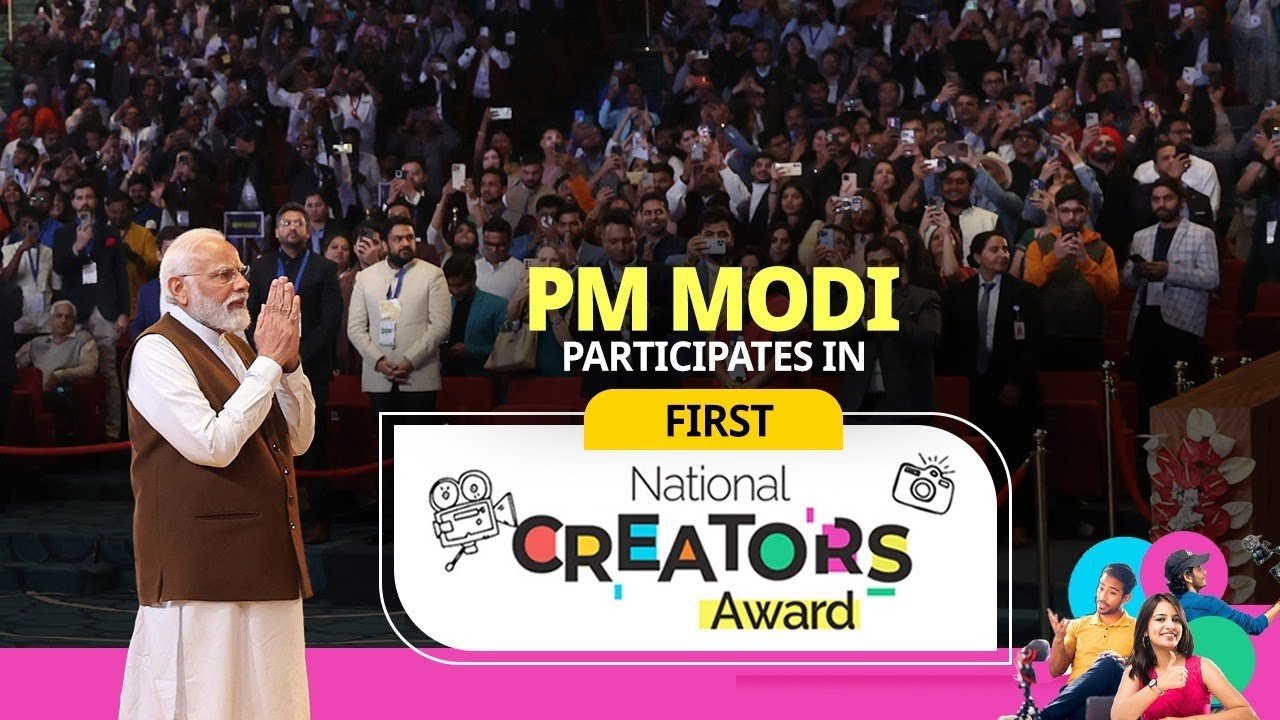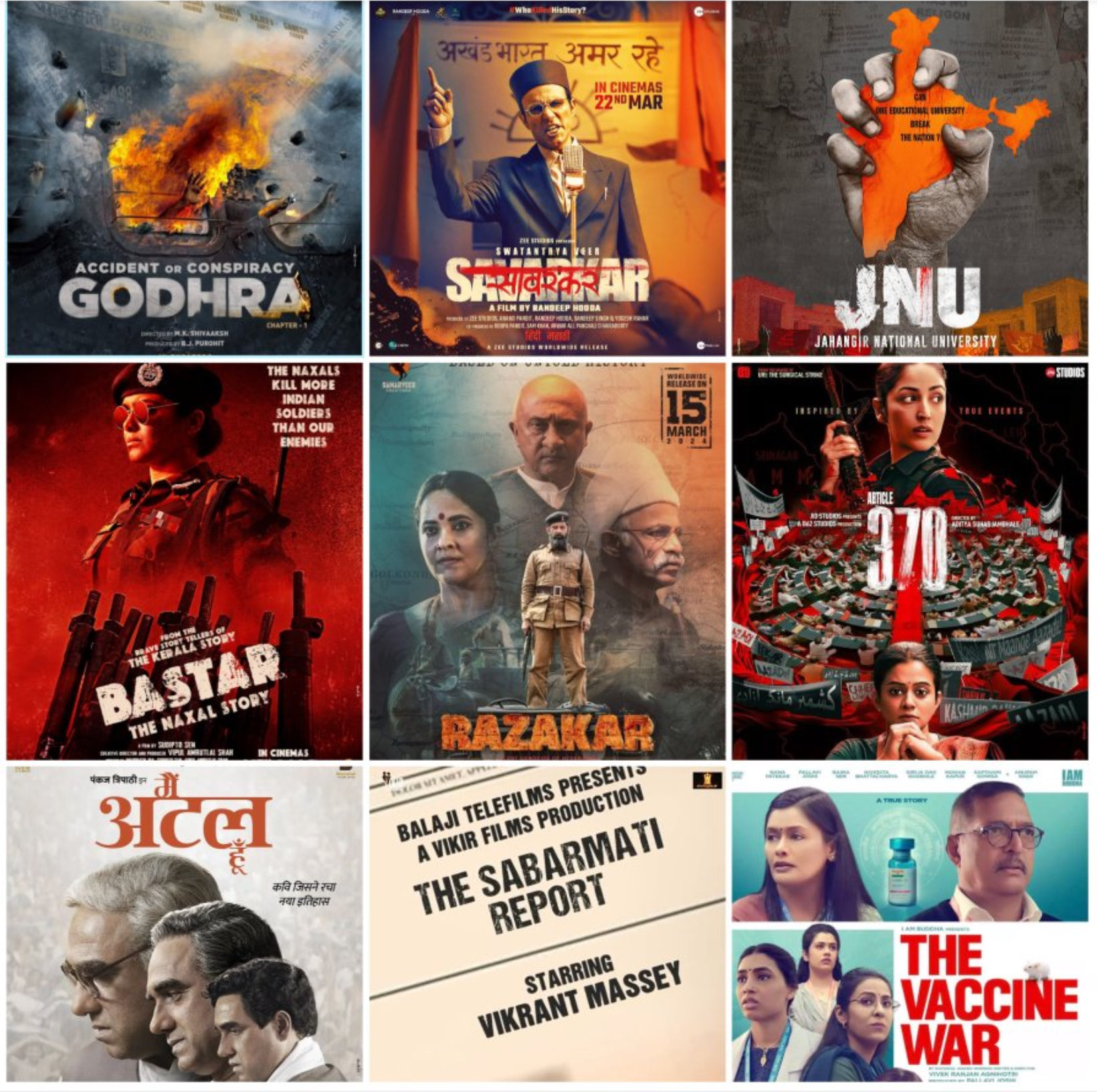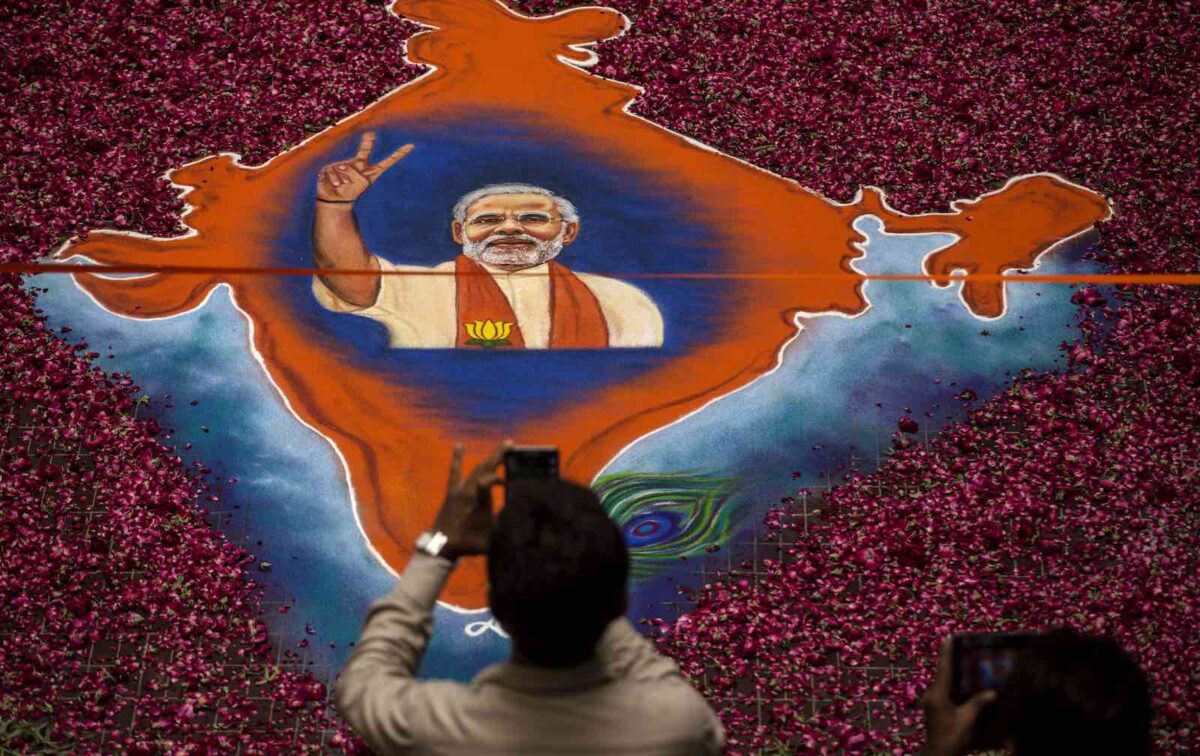Whether you like BJP as a party or not, you must appreciate their strategies! From systematically planning the ‘unconstitutional’ Electoral Bond Scheme to organised usage of new age social media, they are a pro in everything, unfortunately. How beautifully, from National Creator’s award to propaganda films, the BJP has exploited every social media platform to circulate its message to every corner of the country is really admirable.
Read below to get an insight into how the glamorous media has played a role in propagating BJP’s message all over the country.
National Creator’s Award.

With social media’s prominence, the creator economy is expanding at a great pace worldwide. Millions of digital creators on Instagram, Facebook, X, YouTube and other platforms produce content on a variety of topics, including fashion, technology, general knowledge, education, travel, and more. To embrace this, PM Modi launched the National Creators Award in March to honour excellence in storytelling, social change, education, and more, with over 1.5 lakh nominations and 10 lakh votes received. The goal of the awards is to serve as an inspiration for using creativity to promote change.
An insight about the hefty amount spent on promoting the event.
At the awards ceremony, the prime minister stated, “In the next few days, Lok Sabha elections will take place; do not believe that today’s event is being planned because of that.” While PM Modi has expressly stated that the objective of the awards is unrelated to the elections, it is difficult to overlook the amount spent on social media marketing for the award on the eve of the polls. For example, the government spent almost 2.4 crore rupees promoting content from the award event on social media.
MyGov, a digital platform under the Ministry of Electronics and Information Technology, Government of India, spent1.4 crore rupees on Meta advertisements between March 10 and March 16 to promote videos featuring India’s prominent influencers praising the prime minister, according to Meta’s Ad Library. This equates to an expenditure of more than 20 lakh rupees every day on Meta platforms.
According to Google’s Ads Transparency Centre, the Central Bureau of Communication, which is part of the Ministry of Information and Broadcasting in India, spent more than one crore rupees on video ads on Google between March 10 and March 16, 2024. Most of these videos show creators talking about their experiences at the awards or interacting with the prime minister.
If you see the video uploaded on YouTube about this event, it clearly shows that the event focuses more on PM Modi than the creator’s award. For instance, the video starts with the audience loudly chanting ‘Modi, Modi, Modi’; that eventually marks how the ‘brand Modi’ is ingrained in the minds of the people. This is followed by the opening words of podcaster Raj Shamani, who, instead of defining the creator’s award or the digital economy, speaks more about how PM Modi is a trend. One of the ads revolved around this moment of the award ceremony, and it was promoted for around 75,000 rupees.
Analysing the winners’ social media accounts.
It is also great to look at the folks who received the National Creators Award. The review revealed that 15 of the 23 winners had shared content that fell into one of three categories: religious content, meeting BJP leaders, or backing the ruling party’s politics or ideology. Some influencers have posted content that may be classified into two or three of the categories listed above, but in this analysis, one influencer has only been allocated to one group for clarity.
These seven winners actively share Hinduism-related content.
If you spend a lot of time on YouTube, Ranveer Allahbadia is no new. Ranveer Allahbadia, renowned for his YouTube channel BeerBiceps, received the “Disruptor of the Year” award. He routinely posts films about Hinduism, which is a big talking point for the ruling BJP. While not all of his stuff is religious, he does have some videos, like “Who Is SHIVA?” and “Lord Ram, Hanuman Ji, & Sita Mata – Lessons From The Ramayana”. Moreover, there were many podcasts on his YouTube channel with prominent BJP leaders like Nitin Gadkari, Smriti Irani, Dr Jaishnakar and more. However, he has videos with opposition leaders as well.

Jaya Kishori, who describes herself on Instagram as a “Spiritual & Motivational Speaker,” won the “Best Creator for Social Change” award. Her YouTube channel, which has 3 million members, has her singing a variety of religious songs and bhajans. Her dedication to Hindu deities is evident in her YouTube videos, which include names like “Ram Ayenge,” “Mann me Ram,” “Jai Jai Radha,” and more. Similarly, Maithili R Thakur, who presents videos of herself singing Hindu songs, received the “Cultural Ambassador of the Year” award.
Janhvi Singh, who got the “Heritage Fashion Icon” award, routinely posts videos about Hinduism and other topics. For example, in these videos, she explains many thoughts and ideas from the Bhagavad Gita and Mahabharata. Aridaman, known as @vedic_siddhanta on Instagram, received the “Best Micro Creator” award. As his handle suggests, he posts Hindu-related videos and discusses Sanatan Dharma and other themes found in Hindu religious literature.
Kamiya Jani, the founder of the travel and food discovery website Curly Tales, received the award for “Favourite Travel Creator.” She has earlier aired food-related podcasts with BJP Ministers Nitin Gadkari, Smriti Irani, and Anurag Thakur. In April 2023, she published a documentary about PM, which was shared on both PM’s official YouTube account, DD National, and her own channel, Curly Tales.
In March 2024, she posted a series of three videos titled “India In Motion,” in which she tagged Doordarshan’s YouTube channel in the description. All of these videos highlight the government’s ‘good’ activity in rail, aviation, and road transport. However, it is unclear whether she collaborated with Doordarshan on the videos. However, sheave a similar video with Rahul Gandhi as well.
RJ Raunac, a 93.5 FM radio jockey, won the “Most Creative Creator Male” award. Although he does not usually publish videos about politics, he has posted a video about the G20, “Bharat: The Boss,” in which he discusses the pride that Indians feel because the G20 is being held in India. In another video with the thumbnail title “India Banega Bharat?”, he discusses naming India Bharat.
In the media and on TV, various BJP officials and spokespersons have discussed both of these topics.
The event began with the presentation of “The New India Champion” award to popular digital news creators Abhi and Niyu, who have posted multiple videos supporting the ruling government’s policies. For example, one of their videos indicates, “National progress will begin today with the construction of the Ayodhya temple.”
Not only the creativity of creators or the their BJP related videos fetched them this award. If you look carefully, awards are also presented to those who criticise other creators that question the ideologies of BJP governmnet. One such example is from these creators Abhi and Niyu, who without naming, took a jibe on another YouTuber Dhruv Rathee who has seen questioning the ideologies of BJP government. So, one may never know what revolves around the criteria of chooosing partcipants for getting the award.
Not only the BJP but also other political parties are piloting this social media campaign. Political parties in India are leveraging the power of social media influencers to interact with the people. This is especially essential given that about 20 crore young voters between the ages of 20 and 29 and 1.9 crore first-time voters between the ages of 19 and 20 are scheduled to vote in the 2024 General Election.
Now, about the big screen.
Till here, we have seen how small screens have thoughtfully been employed by the BJP government to spread their messages across the youth of the country. Now, let’s dive deeper into the big screens and understand how Bollywood has provided a platform for producing propaganda films to distribute BJP’s message and justify its actions to a broader audience.
The term “propaganda,” which comes from Latin and means “to spread or propagate,” can refer to Films Division newsreels praising government policies and wartime efforts to bolster national morale. In this context, it simply refers to the pro-government film or, more specifically, the pro-BJP government film.
Ideology-laden films first appeared around 2019, just before Narendra Modi’s second term as Prime Minister. As the BJP-led coalition seeks a third term, they have been pouring out of the pipeline. They differ from the social messaging-driven film, which aims to promote common values like justice, equality, and secularism.
Rather, propaganda films use loosely fictionalised events and characters to promote the interests of the BJP government. They advocate for Hindutva, the philosophy that underpins the BJP and its affiliated organisations. They have a ripped-from-the-headlines vibe, with narratives that examine current affairs. The following can be categorised as propaganda films.

- The Kerala Story
- Bastar – The Naxal Story
- Article 370
- The Kashmir Files.
- JNU: Jahangir National University
- Accident or Conspiracy: Godhra
- Ram Setu
- The Sabarmati Report
- Emergency
- Swatantrya Veer Savarkar
- Main Atal Hoon
Political and spy thrillers, war films, and biopics that appeal to patriotism have long been staples of the entertainment business, whether in India or elsewhere. But never before has Bollywood raced to produce so many films on divisive issues, either smashing Prime Minister Narendra Modi’s opponents or leveraging on growing Right-wing nationalism.
In the past also, Bollywood has been employed to influence the electorate and there is nothing wrong with that. However, if there is an inclination towards one end, that could lead to polarisation, which is definitely not acceptable in a democracy. Also, some of these films are even exempted from paying taxes in BJP-governed states so that mass people could consume the ideologies of BJP governance.
What seems to be wrong in these films?
Left vs Right.
In a country like India, which is the world’s biggest democracy, one has the right to choose what ideology they want to follow. However, almost all of these propaganda films share one common trait: they are hyperpolitical, nationalist, and sceptical of India’s liberals and leftists. Take the example from the recent JNU: Jahangir National University. Compromising the name of such a reputed organisation for using it as a soft push to the electorate is something questionable, mainly when the BJP’s own high executive members are Alma Mater of the University.

What is more problematic is manipulating actual facts and figures, which could wrongly trigger citizens’ emotions.
The gigantic compromising numbers in The Kerala Story are highly objectionable, thus showing no accountability for the creation by the film manufacturers.
Due to factual mistakes, the filmmaker had to adjust the trailer description from 32,000 women to three women. However, near the end of the film, one of the characters can still be witnessed, claiming that over 30,000 women have been brainwashed, converted, and transported to Syria. Only after the film finished does a disclaimer appear on the screen that reads, “The makers employed their own ways to design the data claimed. They have now filed an RTI to obtain a response from the government regarding the data.” ‘The Kerala Story,’ a film trapped between sensationalism and poor directing, fails to send the appropriate message while fueling hatred.
Targeting one specific religion.
The main target of Hindutva was always a hidden punching bag for propagandist films. While the administration has demonised and criminalised Muslims since 2014, the community’s negative image in Hindi movies precedes the current political era.
Muslims are almost usually the antagonists in terrorism-themed films, war dramas, and espionage thrillers, as Kashmiri militants, local Quislings, or Islamist terrorists who collaborate with the Pakistan Army and secret agency. Uri: The Surgical Strike (2019), Tejas (2023), Fighter (2024), and Operation Valentine (2024) are films that describe successful military missions against the real-life Pulwama suicide bombing in 2019, which killed 40 Central Reserve Police Force soldiers.
It is definitely an honour to watch these films about how Indian soldiers are competent enough to give a tit-for-tat reply to the goons; however, in several of the films, Indian Muslims have been shown to be a helping help for Pakistani-trained terrorists and their success. This creates a communal hatred in the society.
The recent release of ‘The Kerala Story’ on Doordarshan exemplifies how the BJP administration continues to make soft attempts to influence voters. Senior Congress MP Shashi Tharoor has criticised Doordarshan, the public service channel, for airing the film “The Kerala Story,” claiming that it seeks to portray Kerala as “some form of Pakistan.” Even though it is widely recognised that the film compromises on genuine data, it continues to air despite controversy, exemplifying how electorates are targeted to ‘select’ their governments, which jeopardises the democratic notion of ‘free and fair elections’.
The bottom line.
Spending a considerable amount on election campaigns, which can include big and small screens, can be considered normal. However, spending such huge amounts to advertise a YouTube event can potentially misuse funds. Specifically, at times when indexes mention that India is going through a deep poverty phase, the gap between rich and poor is alarmingly increasing, the jobs are decreasing and many more. In such scenarios, using money for advertisements is a matter of enormous concern for the common man.
Whether social media or big screens, the usage of every medium is acceptable to get the electorates on board; however, at some point, crossing the boundaries by BJP is questionable as it will divert the country from the idea of ‘free and fair elections’.



